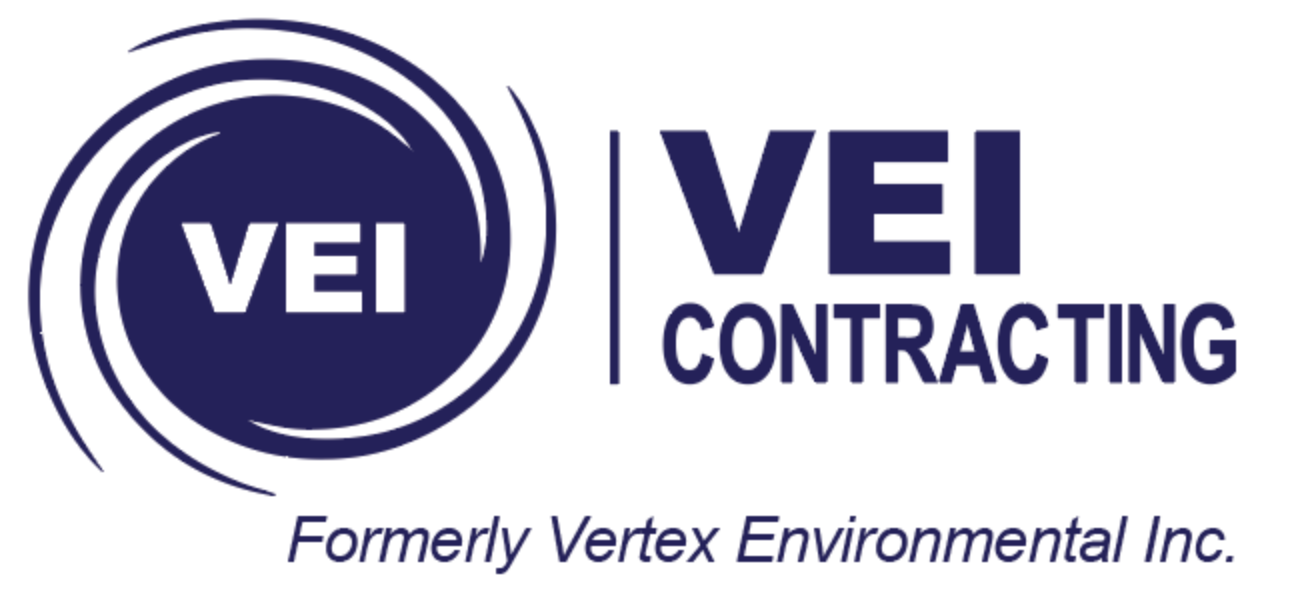Insights from the 2018 Remediation Technologies (RemTech) Conference
Earlier this year, our newsletter focused on What’s New in Our Environmental Industry by presenting insights from the 2018 Battelle Conference on the Remediation of Chlorinated and Recalcitrant Compounds. We remarked that one of the best ways to determine current and new trends in our environmental industry was to attend high-end conferences to take in the presentations, the posters, and talk to the attendees. Let’s go to arguably the best Canadian Environmental Conference…

This year Bruce Tunnicliffe, Nathan Lichti and Kevin French attended the Remediation Technologies Symposium 2018 (RemTech™ 2018) conference in Banff, Alberta. RemTech may be the biggest and best environmental remediation conference in Canada. This year, the 17th, it featured 3 days, 4 streams a day, and over 80 talks! About 800 people registered for the event that took place at the beautiful Fairmont Banff Springs Hotel.
The stunning views…
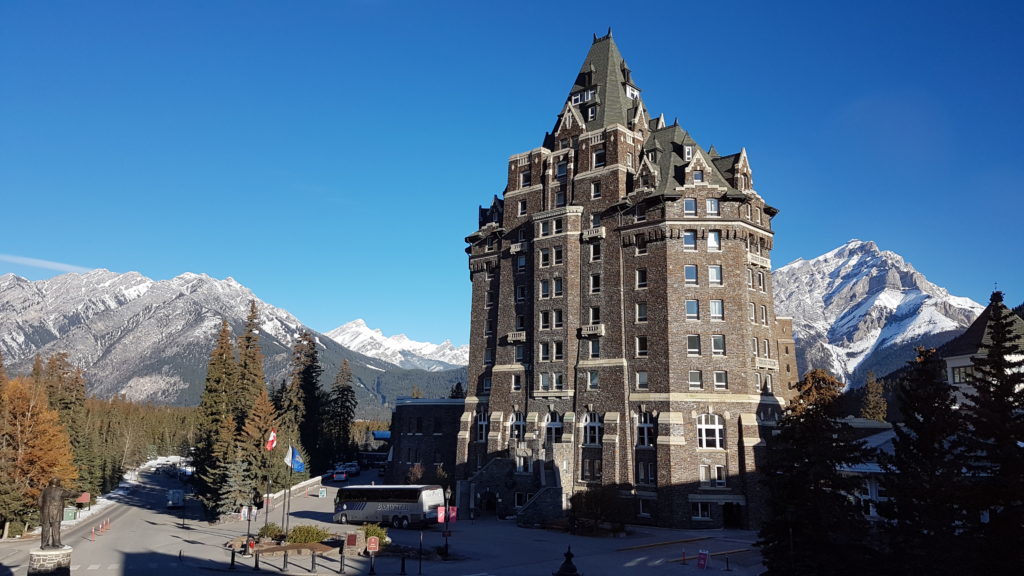
The big crowds…
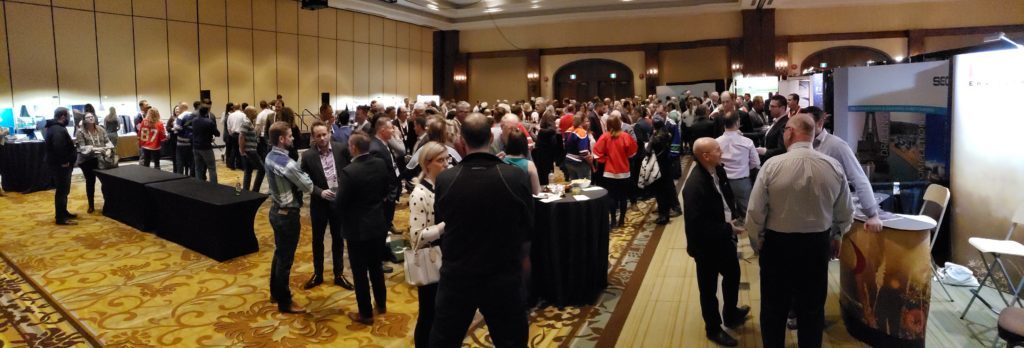
Key Take Aways
With regards to the main differences between this years’ Battelle and RemTech conferences, and what was of interest during the RemTech 2018 conference, we’ll outline our comments under the following categories:
- Petroleum Hydrocarbons
- Other “Hot” and Emerging Contaminants of Concern
- But What about Chlorinated Solvents?
- Working Smarter, Not Harder
- Time Lag
Petroleum Hydrocarbons
The talks were well distributed at RemTech considering contaminants and approaches, but it was not a surprise that more talks focused on Petroleum Hydrocarbons (PHCs) than other contaminants. This comment is made in comparison to a focus on chlorinated solvents at the Battelle Conference (called a Conference on the Remediation of Chlorinated and Recalcitrant Compounds). The focus on PHCs is appropriate for RemTech given its location in Alberta, with its important petroleum industry and associated environmental issues.
There were a wide variety of talks this year on PHC assessment and remediation ranging from Permeable Reactive Barriers (PRBs) for PHCs to better methods for the forensic assessment of PHC plumes and sources to the assessment and remediation of a light, non-aqueous phase liquid (LNAPL) plume in bedrock to Bruce Tunnicliffe’s talk on PHC Remediation of a Complicated Site Using a Multi-Technology Approach.
An interesting observation made at this years’ event relates to the emergence of anaerobic biodegradation of PHCs under reducing conditions. It has long been recognized that PHC plumes naturally biodegrade in the subsurface and pass through various redox zones following the sequence from oxygen to nitrate to manganese to iron to sulphate to methane (all except the first being reductive).
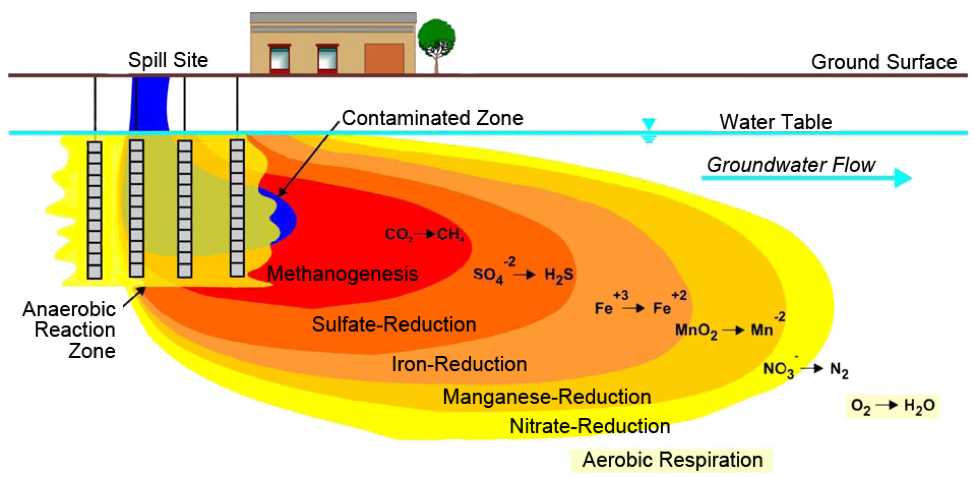
Credit: www.clu-in.org
It is well known that aquifer conditions in the vicinity of a PHC plume are usually naturally anaerobic, yet there continues to be a predominant focus in our Canadian industry on bioremediation of PHCs using quickly consumed oxygen. While aerobic biodegradation may proceed more quickly, some studies have shown that it is the least efficient degradation pathway, is not as suitable for heavier molecular weight PHCs, and requires much more effort and cost to maintain aerobic conditions in an aquifer that is already anaerobic due to the presence of PHCs.
We have begun to see a shift in perception of bioremediation approach for PHCs in our Canadian industry, and have started promoting this approach at many PHCs sites either through the use of Trap & Treat® BOS 200® (i.e., a combination of activated carbon adsorption and enhanced anaerobic biodegradation) or through the implementation on sulphate-enhanced anaerobic biodegradation on its own.
In other PHC observations, an interesting term came out of a presentation on PHCs: “spontaneous imbibition test” – look it up or ask us what it is. (Hint: it’s used to assess LNAPL mobility from soils.)
Other “Hot” and Emerging COCs
Apart from PHCs, other “Hot” Contaminants of Concern (COCs) included salts, heavy metals and PFAS.
Salt
Salt-impacts are often coincident with PHC-impacted sites in Alberta and other oil and gas producing areas of the country, and can be due to additives in the drilling fluids used, as well as naturally-occurring briny aquifers that can be encountered during drilling in these areas. All of this combines to form saline Produced Water that requires treatment or management. Salt has become an environmental concern and focus of regulation due to its recognized risk to plants, animals and the aquatic environment. In fact, road salt is a substance that was placed on the Priority Substance List and recommended for addition to the List of Toxic Substances managed under the Canadian Environmental Protection Act.
Due to their very nature, being extremely soluble and conservative ions, sodium and chloride are notoriously difficult to remediate. Many methods have been attempted to varying degrees of success at sites including excavation and off-site disposal, in-situ flushing, heap leaching, cationic exchange using calcium, etc. Being elements, sodium and chloride cannot be destroyed or degraded, unlike most organic compounds. Therefore, the challenge is and will continue to be to find a way to either immobilize or remove this compound from the subsurface. Some recent developments, including the use of polymers and zeolites to immobilize salts show early promise, but this will likely continue to be a COC for quite a period of time to come. In the interim, risk assessment, risk management and monitored natural attenuation (MNA) may be the best approach for dealing with salt-related impacts.
Heavy metals
Heavy metals have always been on the environmental radar due to their toxicity and it looks like our industry’s knowledge of groundwater remediation has advanced by leaps and bounds in the last few years. Heavy metals in soil still remain a concern due to the inability to degrade or destroy these elements, but many leachable metals can now be immobilized onto soil particles rendering soils non-hazardous and less of a risk to groundwater. Our recent advances in understanding how to remove heavy metals from groundwater using natural mechanisms (i.e. reduction, complexation, co-precipitation, adsorption, precipitation, etc.) is especially important to the mineral mining industry that often has tailings management requirements related to Acid Rock Drainage (ARD) in addition to many historical industrial sites, including tanneries and plating facilities.
One especially interesting talk discussed the potential for the in-situ remediation of a copper plume using the injection of a solution of a ferrous sulphate and an oxygen source, which reacted in-situ and rusted (formed hydrous ferric oxides) on the surfaces of soil particles that resulted in permanent co-precipitation and adsorption of the copper out of groundwater. Pretty sophisticated use of geochemistry!
PFASs
As with the Battelle conference, there were several talks at RemTech that focused on Per- and Polyfluorinated Alkyl Substances (PFASs), such as PFOS and PFOA. It is quite clear that while we somewhat understand this emerging group of contaminants there is still much to learn. Due to their complexity, we expect PFASs will be a “Hot” emerging contaminant of interest for some time into the future.
But What about Chlorinated Solvents?
In our experience, chlorinated solvents (a.k.a. cVOCs) are almost as common as PHCs in terms of the total number of contaminated sites that we are asked to review and assess for remediation. After all, dry cleaners and industrial degreasing operations that historically used chemicals such as tetrachloroethylene (PCE), trichloroethylene (TCE) and 1,1,1-trichloroethane (TCA) were almost as common back in the day as gas stations and heating oil tanks.
cVOCs are toxic (some are known carcinogens), persistent in the environment, and can represent significant vapour intrusion risks, and thus they are unquestionably an environmental issue warranting consideration.
It is an interesting observation that cVOC talks at the Battelle conference (that has a focus on chlorinated solvents) are so prevalent while at RemTech cVOCs play second fiddle to PHCs.
In our opinion, both are equally important to focus on for environmental remediation, and thus it is good to attend both conferences to obtain a balanced view of the relative importance of both classes of compounds.
Working Smarter, Not Harder
As the environmental remediation industry matures and gains experience, it becomes more sophisticated and capable. A decade ago many remedial technologies used a blunt force approach: overwhelm the natural geochemistry of the subsurface and force it to do what you wanted it to do.
As we get older we get wiser. Many of the latest remedial technologies now use existing geochemical conditions to facilitate remediation, usually by enhancing the natural conditions and processes that are taking place or else working with the constraints. For example, if an aquifer is anaerobic and reducing it is acknowledged that it takes a lot of effort to change and maintain it in an aerobic and oxidative condition. Consideration is now given to matching remedial approach with existing subsurface conditions.
This is the driver behind the increasingly common use of anaerobic bioremediation for PHCs, as well as other COCs including cVOCs and heavy metals. Today it is possible to make subtle modifications to the geochemical properties of aquifers to better distribute amendments and achieve remediation. One interesting presentation at RemTech this year that demonstrated this approach uses the natural anaerobic biodegradation of ferrous iron, sulphur and organic carbon solutions to form specific iron deposits that then achieves the chemical reduction of cVOCs. This combination of biotic and abiotic processes makes the introduction, distribution and in-situ remediation of the CVOCs easier and more effective.
Overall, there is a trend towards not working against geochemical conditions, but rather making them work for you. Why fight Mother Nature? Work smarter, not harder!
Time Lag
As we noted in our previous Battelle newsletter, this was the break out year for injectable activated carbon amendments, which is activated carbon usually mixed with a remedial amendment. The US EPA has indicated in-situ use of activated carbon is allowable and acceptable and provided numerous examples of how adding injectable activated carbon substrates is beneficial. It was mentioned that activated carbon substrates has been selected at Federal sites when (i) immediate risk to receptors needs to be mitigated, and (ii) contaminant migration out of a source area needs to be controlled.
There appears to be a strong trend towards the increased application of Injectable Activated Carbon Amendments in the marketplace south of the border. There was an old adage in the environmental industry that Canada has typically lagged about 10 years behind the US in regulation and technology. Perhaps this adage is unfair, but the US sites are larger and have more money to try new and different remediation ideas. Using Trap & Treat® as a case in point, RPI in the US developed these products in the early 2000s and its use took off there in the mid-2000s. We saw the use of Trap and Treat products catch on in the mid-2010s in Canada, and now is a widely applied remedial solution.
Closing Thoughts
After all of the conferences we have attended and presented at this year, it is still quite clear that our industry is an ever challenging and dynamic one. While it’s interesting to see how much we’ve evolved, it is also apparent how much we still have to learn and how much farther we still have to go.
Lastly, at the end of the day, once all of the technical learning and networking opportunities are done and the name tags come off…
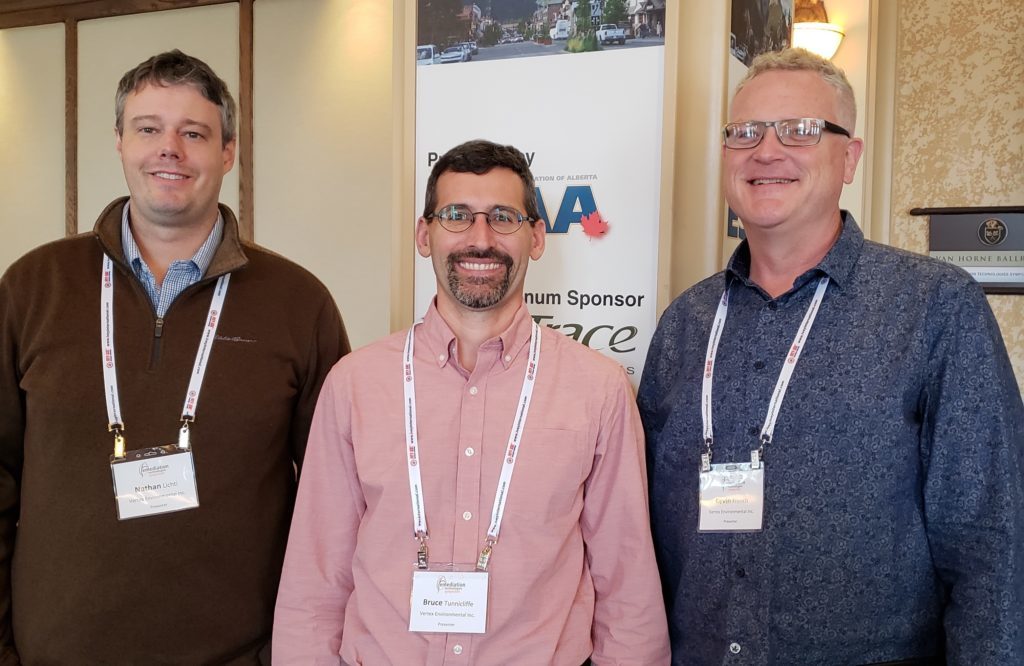
Nathan Lichti, Bruce Tunnicliffe, Kevin French
There are ample opportunities to wind down and grab a beer…
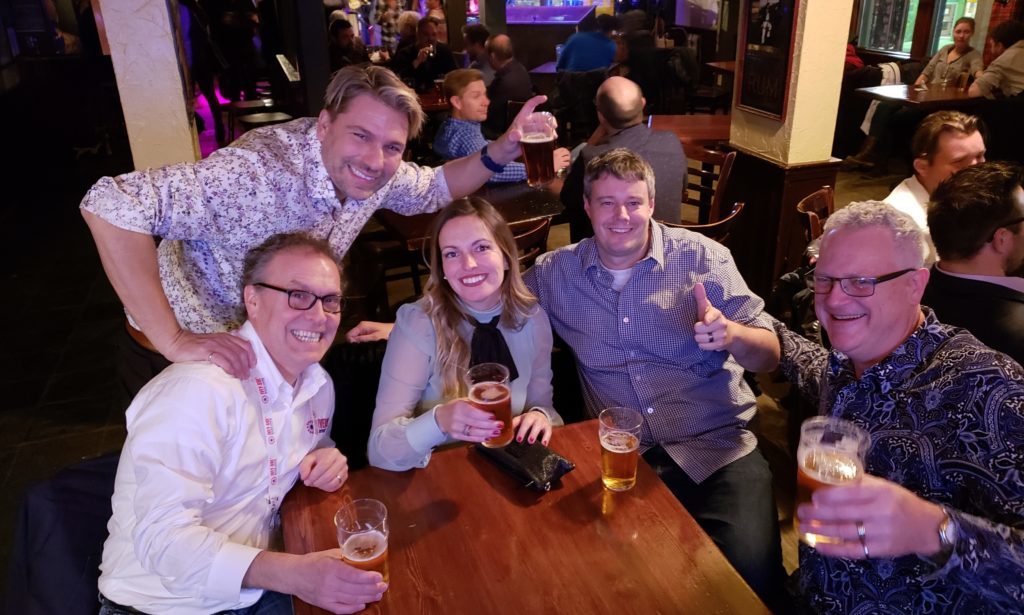 …or even do some role-playing?!?
…or even do some role-playing?!?

Happy conferencing,
Bruce, Kevin and Nathan
